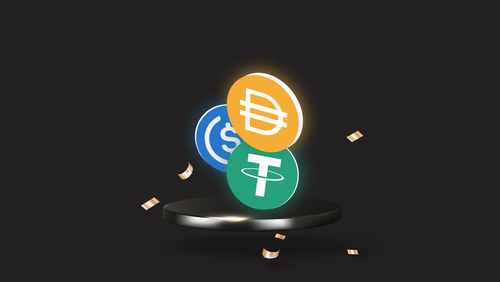

Summary
- Stablecoins are cryptocurrencies that are supposed to maintain a 1:1 peg against a reference asset (e.g., USD).
- There are three main types of stablecoins: fiat-backed, crypto-backed, and algorithmic. Others include commodity-backed and hybrids between the others.
- Stablecoins can break their peg, and this can have catastrophic consequences for crypto markets.
What Is a Stablecoin?
Stablecoins are cryptocurrencies whose value is pegged to that of another financial instrument (e.g., fiat currency or another cryptocurrency). They are most often pegged to the US dollar.
Enjoying this Explainer? Sign up to our free newsletter for more.
Types of Stablecoins
There are several types of stablecoin. The biggest differentiator is usually what they are pegged to and how they are backed. That is, how they are supposed to maintain their peg. The main types include:
- Fiat-backed stablecoins. These aim to be fully collateralised with fiat currency or other assets. The typical collateral includes dollar cash, treasuries and commercial paper. Notable fiat-backed stablecoins include Tether (USDT) and USD Coin (USDC).
- Crypto-backed stablecoins. These are also collateralised, but with cryptocurrencies such as ethereum rather than fiat currency. Given the volatility in crypto assets, these stablecoins are over-collateralised. Notable crypto-backed stablecoins include DAI.
- Algorithmic stablecoins. These aim to maintain a price peg using an algorithmic process as opposed to collateralisation. They do this by using smart contracts to control the supply of the coins in circulation. Notable algorithmic stablecoins include FEI, USDD, and the now defunct TerraUSD stablecoin.
- Hybrid stablecoins. These combine elements of both collateralisation and algorithmic rules. Notable hybrid stablecoins include FRAX.
Other types of stablecoins also include those backed by a commodity. These stablecoins are pegged to the value of commodities such as precious metals, oil, or real estate. Tether Gold (XAUT) is an example – one XAUT token should represent one fine troy ounce of gold on a London Good Delivery bar.
How Do You Use Stablecoins?
Stablecoins have several use cases. Some of the top stablecoin uses include:
- A store of value. Stablecoins should be stable assets, which should make them a suitable store of value.
- Medium of exchange. Stablecoins are designed to minimise volatility between themselves and the asset they are pegged against (e.g., USD). So they are naturally suitable to bridge the gap between fiat and cryptocurrencies.
- Trading. Trades use stablecoins to cash in and out of crypto investments quickly without paying high fiat on-ramp or off-ramp fees. For example, Tether (USDT) is used in some of the most traded pairs on some of the largest exchanges (e.g., Binance).
- Liquidity Providing. Investors can use stablecoins on decentralised exchanges (DEXs). A user can become a liquidity provider for a pair that includes a stablecoin on a DEX and earn a share of the fees paid to facilitate trades between the pair.
- Lending. One of the biggest uses for stablecoins is the ability to earn high yields on deposits to various DeFi protocols. Users can deposit stablecoins onto a DeFi lending platform, which then lends them out to borrows with interest. You earn a portion of that interest charged for providing funds.
- Payments. They offer the ability to make fast payments across the world without interacting with centralised financial intermediaries.
Are There Disadvantages to Stablecoins?
Stablecoins, as the name suggests, should minimise the volatility between themselves and the asset they are pegged against. However, the peg can break, and this can have catastrophic implications for cryptocurrencies.
The TerraUSD (UST) Collapse
The most notable example is TerraUSD (UST). This was an algorithmic stablecoin that the Terra protocol issued. TerraUSD (UST) was linked to Terra’s native token, LUNA, via an arbitrage mechanism that was designed to simultaneously maintain its dollar peg and ensure LUNA’s long-term growth. One UST can always be swapped for $1 worth of LUNA. And to mint 1 UST, $1 worth of LUNA must be burned.
When the UST price is lower than $1, arbitrageurs can use the discounted UST to receive $1 worth of LUNA. They can then sell the LUNA on open markets and profit from the difference (the opposite is true when UST is above $1). The key point is that to realise that profit, LUNA must be sold.
This process worked while crypto markets were bullish. This was because the speculative demand for LUNA was substantial, so any selling from UST arbitrageurs had little effect on LUNA’s price.
However, as crypto markets started to suffer from rate hikes and inflation, the cracks began to show. The system fails when markets are declining as there is less speculative demand for LUNA. The combination of already decreasing prices and sell pressure from UST arbitrageurs causes prices to decline further, which eventually led to a break of the peg and a collapse of the system (Chart 1).
Recently, Tron (TRX) launched an algorithmic stablecoin called USDD that operates in a very similar manner to that of TerraUSD (UST). It has also broken its peg (Chart 2). This highlights a challenge with algorithmic stablecoins in particular. But peg breaks have also occurred in fiat-backed and crypto-backed stablecoins too.
Transaction Fees
Other disadvantages of stablecoins include on-chain transaction fees. For stablecoins to be useful as a means of payment, transaction fees on the blockchain pm which they are implemented must be low. Most stablecoins are implemented on the ethereum blockchain, which has been criticized for its high transaction fees. However, this should change after the merge, when ethereum transitions from proof-of-work to proof-of-stake. Other ways to combat this are to implement stablecoins on low or no-fee blockchains.
How to Invest in Stablecoin
Investors can get exposure to stablecoins through any of the mainstream crypto exchanges or digital wallets where you can buy crypto. Centralised exchanges such as Coinbase may offer stablecoins, but you can also get exposure to them through DEXs and DeFi lending/borrowing platforms.
Top Stablecoins
Here are some details around some of the most popular stablecoins, with Table 1 showing the most recent market data for each.
USDT: Tether is a fiat-collateralised stablecoin. It is primarily issued on the ethereum and bitcoin blockchains. It aims to be pegged 1:1 against the US dollar. Tether’s reserves are not backed 100% by US dollar deposits. Instead, they are backed by reserves that include cash, cash equivalents, short-term deposits, commercial paper, corporate bonds, funds, precious metals, secured loans, and other investments including digital tokens.
USDC: USD Coin is a fiat-collateralised stablecoin issued as ERC-20 tokens on the ethereum blockchain. It is 100% backed by cash and short-dated US treasuries. USDC publishes a monthly public attestation of 100% reserves.
BUSD: Binance USD is a fiat-collateralised stablecoin issued as ERC-20 tokens on the ethereum blockchain. It is backed 100% by USD held in Paxos-owned US bank accounts and US treasury bills (including through repurchase agreements and/or money-market funds invested in US treasury bills). Paxos is a New-York-regulated financial institution and publishes a monthly public attestation of 100% reserves.
TUSD: TrueUSD is a fiat-collateralised stablecoin issued by the TrustToken platform that is issued as ERC-20 tokens on the ethereum blockchain. It aims to maintain its 1:1 peg against the US dollar by being fully collateralised by US dollars using multiple escrow accounts to reduce counterparty risk.
USDP: Pax Dollar is a fiat-collateralised stablecoin issued as ERC-20 tokens on the ethereum blockchain. It aims to be pegged 1:1 against the US dollar by holding USD reserves in Paxos owned US bank accounts.
DAI: Dai is a crypto-collateralised stablecoin. It attempts to maintain a 1:1 peg against the US dollar by depositing other crypto assets into smart contracts on the ethereum blockchain every time a new DAI token is issued. DAI is maintained by a decentralised autonomous organisation (DAO) called MakerDAO. And since the mechanism is maintained by a system of smart contracts, it has higher decentralisation than the centralised entities controlling USDT, USDC, or BUSD.
MIM: Magic Internet Money is a crypto-collateralised stablecoin launched by the DeFi platform Abracadabra. MIM is backed by interest-bearing tokens (ibTKN).
UST: TerraUSD is a crypto-collateralised hybrid stablecoin native to the Terra blockchain. To mint 1 UST, $1 worth of UST’s reserve asset, LUNA, must be burned. The idea was to try and ensure LUNA’s long-term growth. More people buying into UST means more LUNA gets burned, which should make the remaining LUNA supply more valuable. However, the system collapsed recently when UST de-pegged from the US dollar.
FRAX: Frax Finance is a fractional-algorithmic stablecoin that uses both collateralisation and an algorithmic process to create its decentralised stablecoin that is pegged 1:1 to the US dollar. The protocol only accepts stablecoins (currently, USDC) as collateral.
FEI: FEI is an algorithmic stablecoin that aims to be pegged 1:1 against the U.S dollar that is backed mostly by ETH.
Stablecoins Summary Data
FAQs
→ How do stablecoins work?
Stablecoins work by being pegged to the value of another financial instrument such as a fiat currency or another cryptocurrency using collateralization. For example, stablecoins can be fiat-backed, crypto-backed, or commodity backed. Or their peg is maintained by an algorithmic process that controls the supply of coins in circulation using arbitrage mechanisms.
→ Is Cardano a stablecoin?
No, Cardano is an L1 blockchain, and ADA is the native token. However, its blockchain platform could support a stablecoin, and there have been attempts to launch them on the Cardano blockchain.
→ Is XRP a stablecoin?
No, XRP is a cryptocurrency founded in 2012 with an aim to increase the speed and reduce the cost of transferring money between financial institutions.
→ Why use stablecoins?
Stablecoins can be used as a store of value, a medium of exchange, for trading, providing liquidity, lending/borrowing, and facilitating payments.
